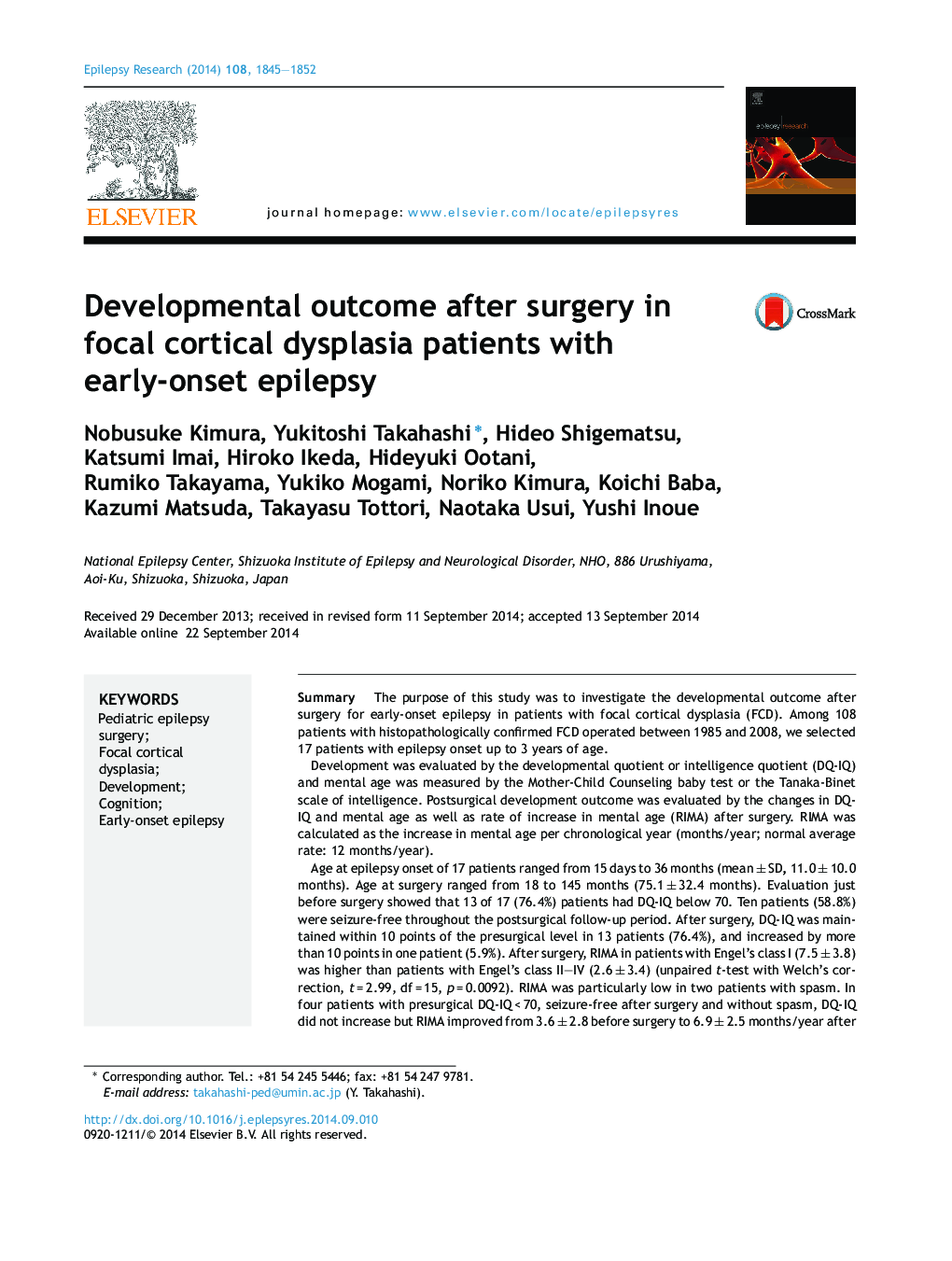| کد مقاله | کد نشریه | سال انتشار | مقاله انگلیسی | نسخه تمام متن |
|---|---|---|---|---|
| 6015522 | 1186070 | 2014 | 8 صفحه PDF | دانلود رایگان |
- 58.8% of focal cortical dysplasia patents with early epilepsy onset became seizure free after surgery.
- 76.4% of the patients had stable DQ-IQ and 5.9% had improved DQ-IQ after surgery.
- Residual seizures after surgery and lower DQ-IQ before surgery were risk factors for the poor development.
- In patients with spasms before surgery, rate of increase in mental age (RIMA) tended to be low after surgery.
- In patients with Engel's class I and lower presurgical DQ-IQ, increase of RIMA appeared from two years after surgery.
SummaryThe purpose of this study was to investigate the developmental outcome after surgery for early-onset epilepsy in patients with focal cortical dysplasia (FCD). Among 108 patients with histopathologically confirmed FCD operated between 1985 and 2008, we selected 17 patients with epilepsy onset up to 3 years of age.Development was evaluated by the developmental quotient or intelligence quotient (DQ-IQ) and mental age was measured by the Mother-Child Counseling baby test or the Tanaka-Binet scale of intelligence. Postsurgical development outcome was evaluated by the changes in DQ-IQ and mental age as well as rate of increase in mental age (RIMA) after surgery. RIMA was calculated as the increase in mental age per chronological year (months/year; normal average rate: 12 months/year).Age at epilepsy onset of 17 patients ranged from 15 days to 36 months (mean ± SD, 11.0 ± 10.0 months). Age at surgery ranged from 18 to 145 months (75.1 ± 32.4 months). Evaluation just before surgery showed that 13 of 17 (76.4%) patients had DQ-IQ below 70. Ten patients (58.8%) were seizure-free throughout the postsurgical follow-up period. After surgery, DQ-IQ was maintained within 10 points of the presurgical level in 13 patients (76.4%), and increased by more than 10 points in one patient (5.9%). After surgery, RIMA in patients with Engel's class I (7.5 ± 3.8) was higher than patients with Engel's class II-IV (2.6 ± 3.4) (unpaired t-test with Welch's correction, t = 2.99, df = 15, p = 0.0092). RIMA was particularly low in two patients with spasm. In four patients with presurgical DQ-IQ < 70, seizure-free after surgery and without spasm, DQ-IQ did not increase but RIMA improved from 3.6 ± 2.8 before surgery to 6.9 ± 2.5 months/year after surgery. RIMA became better from 2 years after surgery. In four patients with presurgical DQ-IQ â¥Â 70 and no spasm, two showed the same or higher RIMA than normal average after surgery.In 58.8% of FCD patients with early onset epilepsy, epilepsy surgery effectively controlled seizures, and in 82.3% of patients, epilepsy surgery preserved or improved development. Residual seizures after surgery and lower DQ-IQ before surgery might be potential risk factors for poor development after surgery. In patients of Engel's class I with lower presurgical DQ-IQ, catch-up increase in mental age was observed after two years following surgery.
Journal: Epilepsy Research - Volume 108, Issue 10, December 2014, Pages 1845-1852
